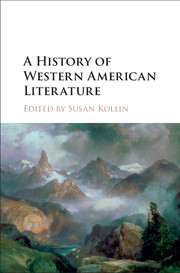Book contents
- Frontmatter
- Contents
- Notes on Contributors
- Acknowledgments
- Introduction: Historicizing the American Literary West
- PART I HOMELANDS
- PART II MAKING A REGION
- PART III GEOGRAPHIES OF THE LITERARY WEST
- 8 Literature of the Great Plains: Nature, Culture, and Community
- 9 Southwest Literary Borderlands
- 10 Imagining the Rocky Mountain Region
- 11 Writing the Pacific Northwest
- 12 The Far North: Literatures of Alaska and Canada
- 13 The Problem of the Critical in Global Wests
- PART IV THE TWENTIETH CENTURY AND BEYOND: LITERARY MOVEMENTS AND CRITICAL PERSPECTIVES
- Selected Bibliography
- Index
11 - Writing the Pacific Northwest
from PART III - GEOGRAPHIES OF THE LITERARY WEST
Published online by Cambridge University Press: 05 November 2015
- Frontmatter
- Contents
- Notes on Contributors
- Acknowledgments
- Introduction: Historicizing the American Literary West
- PART I HOMELANDS
- PART II MAKING A REGION
- PART III GEOGRAPHIES OF THE LITERARY WEST
- 8 Literature of the Great Plains: Nature, Culture, and Community
- 9 Southwest Literary Borderlands
- 10 Imagining the Rocky Mountain Region
- 11 Writing the Pacific Northwest
- 12 The Far North: Literatures of Alaska and Canada
- 13 The Problem of the Critical in Global Wests
- PART IV THE TWENTIETH CENTURY AND BEYOND: LITERARY MOVEMENTS AND CRITICAL PERSPECTIVES
- Selected Bibliography
- Index
Summary
One of the Pacific Northwest's famous sons, the poet and essayist Gary Snyder, writes eloquently of bioregionalism, a form of political organization that eschews the “arbitrary” territorial boundaries of nation-states to redefine community around ecological features such as watersheds, the distribution of specific plants, or the range of migratory animals. Snyder's bioregional emphases mirror geopolitical imaginaries long-standing in the Pacific Northwest, from Native American cultures linked to salmon spawning systems to the proposed nation of Cascadia, a northwestern country defined most recently by its capacity for energy independence due to its geothermal and hydrological resources. Before this post-oil Cascadia, there was Ecotopia (1975), a book by Ernest Callenbach and an eponymous nation that figures as a self-sustaining country of foresters, gatherers, and gender-bending counterculturalists. And before Ecotopia, there was Jefferson State, a proposed fifty-first state of the union comprising portions of northern California and southern Oregon and bearing the flag of the “double cross” – literally, two crosses – to express the region's abandonment by state governments who care little for rural constituencies. When John Muir wrote of the Puget Sound in Picturesque California (1888–90), he noted the difficulty of conceiving the Northwest in terms that are social, rather than ecological: “The edges [of Seattle and Tacoma] run back for miles into the woods which hide a good many of the houses and the stakes which mark the lots; so that, without being as yet very large towns, they seem to fade away into the distance.” Muir's defense of Washington State as not “a dim, nebulous expanse of woods,” but rather “near to all the world and its possessions” is lost in literary histories that seize upon his plea to set aside a park to preserve Oregon's rainforest.
The persistence of the Pacific Northwest as an ecological rather than social or political imaginary has been eloquently documented by the Canadian writer Laurie Ricou, whose books Salal: Listening for the Northwest Understory (2007) and The Arbutus/Madrone Files: Reading the Pacific Northwest (2002) rigorously map the cultures of the Pacific Northwest across the U.S.-Canada border by distribution of species, levels of rainfall, and geologic features such as the Kuroshio or North Pacific ocean current.
- Type
- Chapter
- Information
- A History of Western American Literature , pp. 177 - 191Publisher: Cambridge University PressPrint publication year: 2015

